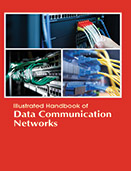Computer Science

Computers are used to generate information. Generated information is not useful in itself. The information must be delivered to the right person at the right time. Often information must be transmitted from one location to another. This process is called data communication. Data communication is the active process of transporting data from one point to another. Networks are communication system designed to convey information from a point of origin to a point of destination. Information communications and computer networking have become essential to the functioning of today’s businesses, large and small. Furthermore, they have become a major and growing cost to organizations. Management and staff need a thorough understanding of information communications in order to assess needs; plan for the introduction of products, services, and systems; and manage the systems and technical personnel that operate them. Illustrated Handbook of Data Communication Networks provides a solid theoretical and practical perspective on Data Communication and Computer Networks.
Communications have played an important role in linking together teletypewriters in manual and automatically switched networks. There is a rapidly growing need for higher speed communications to transmit digital data from remote to centralized locations. New engineering and maintenance approaches are necessary to take advantage of the existing widespread voice communication facilities. In recent years, even the general public has become accustomed to seeing information represented in coded form on punched cards. Coding by marking or punching is an old art. The speed capability of electronics has necessitated the development of new recording methods such as magnetic tape which, in turn, accentuates the need of higher speed communications systems. Computer engineers have suggested that the existing widespread telephone network may be utilized to rapidly accelerate the use of systems which will automatically process practically all types of existing business records.
Illustrated Handbook of Data Communication Networks attempts to offer a comprehensive introduction to computer networks and data communications; the book includes coverage of the language of computer networks as well as the effects of data communications on business and society.
This handbook provides a comprehensive introduction to the field of data communications for both students and professionals.